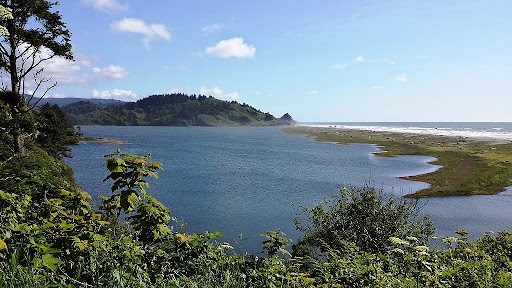Overview
Lagoons as Vital Cultural Ecosystems

Author: Nanette Durbin (Osage Nation / Cherokee Nation)
Lesson partner: Rebecca Lowry, Humboldt County Office of Education
Grade: 6
Suggested Amount of Time: 3-5 day lesson
(Day one slides 90 minutes; Day two field trip; and Day 3 follow up slides & activities 100 minutes)
Curriculum Themes
- Cross Curricular Integration
Learning Goals
Students will learn to:
- Summarize lagoons as important to Indigenous cultures
- Identify who depends on lagoons and wetlands
- Analyze dangers of water pollution to plants, animals, and culture
- Compose and tell a story with a moral or lesson about good lagoon stewardship
Lesson Overview
Students will learn to see lagoons as important to Indigenous cultures and the surrounding communities, including themselves. Students will analyze the dangers of water pollution to the ocean and lagoons to plants, animals, and culture. Students will learn how to identify some of the common plants and animals at a lagoon. Students will learn how to speak about the importance of wetlands and lagoons to Indigenous culture through a story with a moral or lesson about good lagoon stewardship. The ultimate goal is for students to learn the importance of understanding the connection between healthy ecosystems and the resilience of Indigenous cultures.
Teacher Background
Because the people indigenous to a region have a responsibility to the land and water and their human, plant, and animal relations, tribes are tirelessly collaborating on restoration and management of the natural resources on their ancestral lands. Tribes often partner with nonprofits, educational institutions, and the private, city, county, state and federal government entities who hold title to those lands. Tribes offer generations of Indigenous knowledge and stewardship practices which can help to heal the land and water damaged in the times of settler colonialism, and mitigate effects of climate change. This unit will help students understand why tribes are connected to the land and the importance of land stewardship and collaboration with tribes.
Settler Colonialism & land theft
The California gold & timber rush displaced thousands of Native Americans. Non-native people encroached on Native lands committing murder and atrocities. In addition, the State of California State sanctioned genocide against California tribes. California’s first Lieutenant Governor, Peter Burnett advocated for the genocide of California Indians.
Genocide is acts committed with intent to destroy, in whole or in part, a national, ethnical, racial or religious group (citation)
Each region of CA set the dollar amount on a head or a scalp (a bounty) and paid settlers to murder innocent Indigenous peoples in order to take their lands. No treaties were ratified with any tribe in the state of California, and land was stolen without agreement or compensation to any tribe. (citation)
Ancestral Territory
Tribes no longer have control of the majority of their ancestral territories, regions occupied by Indigenous peoples or regions of their ancestors. However, each tribe is working to assert sovereignty in regard to the land and natural resources in their respective territories.
Today, the Wiyot, Yurok, and Tolowa Dee-ni’ peoples are enrolled citizens of (but not limited to) the Wiyot Tribe, Bear River Band of the Rohnerville Rancheria, Pulikla Tribe of Yurok People, Trinidad Rancheria, Big Lagoon Rancheria, Blue Lake Rancheria, YurokTribe, and Tolowa Dee-ni’ Nation. Each tribe’s respective reservation and rancheria is a mere fraction of their original ancestral territories which collectively span from current day southern Humboldt County to just around Grants Pass in southern Oregon.
The Yurok and neighboring tribes successfully worked with state and federal governments in removing the dams from the Klamath River enabling ecosystems to be restored. link to more information
The Wiyot Tribe established the Dishgamu Humboldt Community Land Trust in order to expedite the return of unceded land, stolen land. link to more information
Yurok and Tolowa Dee-ni' share an Indigenous Marine Stewardship Area where they are asserting their unceded, inherent rights and responsibilities to govern, steward, and manage their ancestral lands and waters link to more information
Pollution
Since the 1800s, when California and the United States forced tribes to give up most of their ancestral territories, over 90% of the wetlands in the state have been lost. Restoring wetlands would reduce flooding. A single acre of wetland can store up to 1.5 million gallons of flood water, provide plant and animal habitat, and restore resources for cultural use. link to more information
As tribes regain access and ownership to ancestral lands, some require cleanup from over a century of industrial contamination from lumber treatment, toxic compound production from illicit methamphetamine production, illegal dumping, inadequate septic systems, erosion, agricultural runoff, and automobile related pollution.
The Importance of Sovereignty, TEK, and Stewardship to North Coast Tribes
The original inhabitants of the north coast (and many other cultures) consider humans, plants, and animals as relatives or family. For example, many tribes refer to the bear as “sister bear.” *Traditional Ecological Knowledge informs us that the collective of living beings in a healthy ecosystem sustains life for all. Sovereignty is vital to tribes, it enables them to use TEK in good stewardship practices to help bring lagoons and wetland back into balance.
*TEK has many names—Indigenous knowledge, Tribal knowledge, tribal science, Native science, Indigenous environmental science, Indigenous environmental studies. And this Indigenous knowledge is central to helping solve California’s environmental problems.

